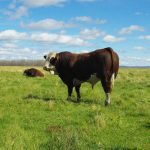
Breeding

Stifle injuries frequently mark the end for breeding bulls
A veterinarian discusses causes, signs and prognosis of stifle injuries in beef bulls.
A veterinarian discusses causes, signs and prognosis of stifle injuries in beef bulls.

Genomic tool identifies hybrid vigour levels in cattle
A made-in-Canada tool reveals breed composition and scores cattle on hybrid vigour
"We found over 25 years the amount of vigour in the commercial beef production sector was decreasing. We needed a tool to monitor the situation and indicate the degree of crossbreeding. This tool would offer workable practices to reinstate hybrid vigour levels.”

Kansas professor highlights role of genetics in the sustainable cow herd
Breeding and selecting beef cattle that fit an operation’s environment benefits a producer’s bottom line and scores sustainability points
Bob Weaber’s work on cattle genetics is for the producer, and so it’s for him, as well. Growing up, his family raised mostly commercial cattle but also got involved in the Junior Hereford Association in the U.S., where he got interested in seedstock, which was further piqued when he went to university. Now, Weaber operates […] Read more

What to consider when changing the breeding season
Producers tightening or shifting their breeding season should consider everything from economics to feeding programs
Trudging through slushy snow in April is a scene many producers know well. One day there’s a hint of summer in the air, with birds chirping in trees overhead as a farmer checks on newborn calves frolicking near puddles. The next day, the farmer is rushing through pastures as hard sleet slashes his face, trying […] Read more

Backing the Bonsma principles in today’s beef industry
A look at how Jan Bonsma’s approach to selection is still influencing some ranchers
A look at how Jan Bonsma’s approach to selection is still influencing some ranchers
Over recent years, many commercial cattle operators have become somewhat disillusioned with the direction of certain segments of the beef seedstock industry. In their view, the common sense guideposts for the most useful animals have been directing them too close to the numbers-dominated terminal growth and carcass traits, often at the expense of maternal, reproductive […] Read more


